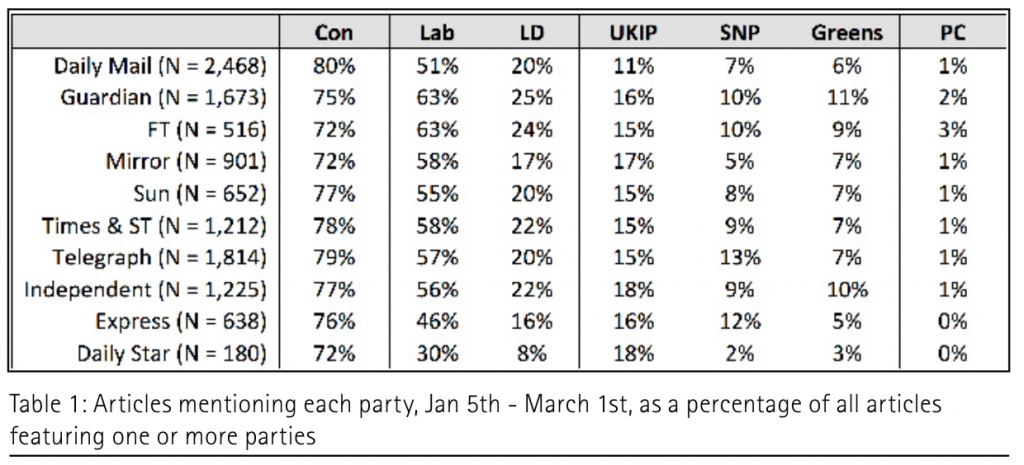Three-D Issue 24: Media coverage, TV debates and minor parties
 Stephen Cushion
Stephen Cushion
Cardiff University
Gordon Neil Ramsay
Media Standards Trust & King’s College London
Despite evidence that the TV debates in 2010 engaged and excited many people – in particular 18-24 year olds – according to the Conservative Party chairman, Grant Shapps, they “sucked the life out of the campaign”. Rather than focus on the issues and policy agendas of the parties, the build-up and post-match analysis of the three TV debates was seen to have mitigated their agenda setting influence. The PM’s team of advisors have long attempted to either dismiss the necessity of the TV leaders’ debates or schedule them prior to March 30th – when Parliament dissolves, the “short campaign” begins and undecided voters are more open to influence.Unsurprisingly, then, the Conservative party rejected the three proposed TV leaders’ debates and its communications director, Craig Oliver, issued a “final offer” to hold just one TV debate well before election day. His letter to broadcasters suggested they had long conspired with Labour and Liberal Democrat spin doctors to prevent left leaning parties from participating in the debates – to avoid losing votes from them – whilst legitimating UKIP’s presence. In doing so, Oliver argued, it would split the Tory vote and enhance Miliband’s Prime Ministerial prospects.However, broadcasters responded robustly and announced they would still stage the TV leaders’ debates and leave open the invitation to David Cameron. At this stage it remains unclear whether the debates will go ahead because “empty chairing” the PM could be open to legal challenge.While many politicians, journalists and pundits have lined up to either justify or condemn Tory party strategy, from a Conservative Party perspective, avoiding the TV debates could prove an effective strategy. After all, broadcasters have to report the campaign impartially. With seven parties involved, a TV debate might be relatively harmless – it would mean the positions and performances of seven leaders would need to be balanced. And, in a far more crowded and chaotic debate, a repeat of Cleggmania – where one candidate stole the show – is perhaps less likely.But if Cameron and Miliband squared up a week prior to voting day – a match up the Tories have firmly vetoed – it would put the parties on equal standing and grant Labour precious airtime. As Conservative commentators have observed, Cameron’s decision to downsize the TV debates could be seen as “shrewd” – preventing the PM from sharing his ‘presidential’ platform.
The economy, Cameron and editorial support
New research from the Media Standards Trust suggests that, rather than competing on broadcasters’ terms during the campaign, the Conservative party agenda is on far safer territory in national newspaper/online news coverage (see https://mediastandardstrust.org/mst-news/election-unspun-launches-today/ for full method and sample details).
In the eight weeks of campaigning from January 5th to March 1st, all the leading online national newspapers reported the Conservative Party to a greater degree than its rivals (see Table 1).
 Similarly, as Figure 1 reveals, Conservative prominence in newspaper coverage extends to the reporting of party leaders. According to the Media Standards Trust, David Cameron has been most visible leader since campaigning in 2015.
Similarly, as Figure 1 reveals, Conservative prominence in newspaper coverage extends to the reporting of party leaders. According to the Media Standards Trust, David Cameron has been most visible leader since campaigning in 2015.
 Of course, Cameron’s appearances alone do necessarily advance the Tory party’s agenda. But another emerging pattern in coverage identified by the Media Standards Trust – in a larger sample of coverage examined – is the dominance of the economy as a campaign issue. As Figures 2 and 3 demonstrate, between February 16th and March 1st the economy was by far the most reported topic. Since opinion polls repeatedly show voters trust David Cameron’s party the most with managing the economy, the attention paid to this policy plays to the Conservatives’ campaign tune.
Of course, Cameron’s appearances alone do necessarily advance the Tory party’s agenda. But another emerging pattern in coverage identified by the Media Standards Trust – in a larger sample of coverage examined – is the dominance of the economy as a campaign issue. As Figures 2 and 3 demonstrate, between February 16th and March 1st the economy was by far the most reported topic. Since opinion polls repeatedly show voters trust David Cameron’s party the most with managing the economy, the attention paid to this policy plays to the Conservatives’ campaign tune.

 But while the Conservative Party, its leader and the economy may be prominently reported in national newspapers, this does not necessarily translate into favourable coverage. After all, it would be difficult to argue Cameron is a much-celebrated leader even in the Conservative-supporting sections of the press. But the Media Standards Trust’s analysis of online leader columns between February 16th and March 1st suggests that, while the Labour is subject to repeated criticisms, the Conservative Party receive more positive commentary in newspaper editorials than any other party (see Figures 4 and 5).
But while the Conservative Party, its leader and the economy may be prominently reported in national newspapers, this does not necessarily translate into favourable coverage. After all, it would be difficult to argue Cameron is a much-celebrated leader even in the Conservative-supporting sections of the press. But the Media Standards Trust’s analysis of online leader columns between February 16th and March 1st suggests that, while the Labour is subject to repeated criticisms, the Conservative Party receive more positive commentary in newspaper editorials than any other party (see Figures 4 and 5).

 With so much media focus on the TV leaders’ debates, as the election campaign gets into full swing broadcasters will remain worried about “empty chairing” a PM. But by standing firm, the Media Standards research suggests that broadcasters might well help broaden the campaign agenda, with leaders from the minor parties being able to share a platform with the PM. Since a hung parliament is predicted to be the most likely outcome, including the possible leaders of potential coalition-building parties in the high profile TV debates seems a sensible way of allowing voters to better understand the choices they face on election day.
With so much media focus on the TV leaders’ debates, as the election campaign gets into full swing broadcasters will remain worried about “empty chairing” a PM. But by standing firm, the Media Standards research suggests that broadcasters might well help broaden the campaign agenda, with leaders from the minor parties being able to share a platform with the PM. Since a hung parliament is predicted to be the most likely outcome, including the possible leaders of potential coalition-building parties in the high profile TV debates seems a sensible way of allowing voters to better understand the choices they face on election day.
Extracts of this article were taken from Total Politics and The Conversation.
